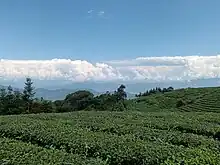pam⁵⁵
Pela

pam⁵⁵
Etymology
From Proto-Sino-Tibetan. Cognate with Burmese ပုံ (pum, “pile, to pile up”), possibly Tibetan ཕུང་པོ (phung po, “pile”), Sichuan Yi ꁧ (bbo, “mountain, pile”), Nusu bɔ³³ (“pile”), Lisu ꓑꓱꓺ (pø̱, “heap, pile”), Naxi ba (“pile”), possibly Japhug rmbɯ (“to pile up”), possibly Tangut 𗪽 (*bur¹, “to gather”), Northern Pumi bu⁵⁵ (“pile”), Jingpho bum (“mountain, to pile up”), Proto-Karen *plomᴮ (“to pile up”), Chepang पोम्ह्सा (pomh sa, “to pile up”), Manipuri ꯄꯥꯝ (pām, “hilly terrain”) and Bokar pum (“to pile up”). Compare Lhao Vo bam, Zaiwa bum, Lashi boem and Longchuan Achang pum⁵⁵.
Pronunciation
- IPA(key): /pam⁵⁵/
Derived terms
Classifier
pam⁵⁵
- numeral classifier for mountains and objects organised in piles
References
- Dai Qingxia, Jiang Ying, Kong Zhien, A Study of Pela Language (2007; Publishing House of Minority Nationalities, Beijing)
- Guillaume Jacques, Esquisse de phonologie et de morphologie historique du tangoute (2014; Brill, Leiden)
- Huang Bufan (editor), Xu Shouchun, Chen Jiaying, Wang Huiyin, A Tibeto-Burman Lexicon (1992; Central Minorities University, Beijing)
- Mangshi Jinghpo ethnicity Association of Development and Progress Studies(芒市景颇族发展进步研究学会)(ed.), Han-Zaiwa-Pela Dictionary (汉文载瓦文波拉语对译词典) (2018; Dehong Nationalities Publishing House, Mangshi)
This article is issued from Wiktionary. The text is licensed under Creative Commons - Attribution - Sharealike. Additional terms may apply for the media files.